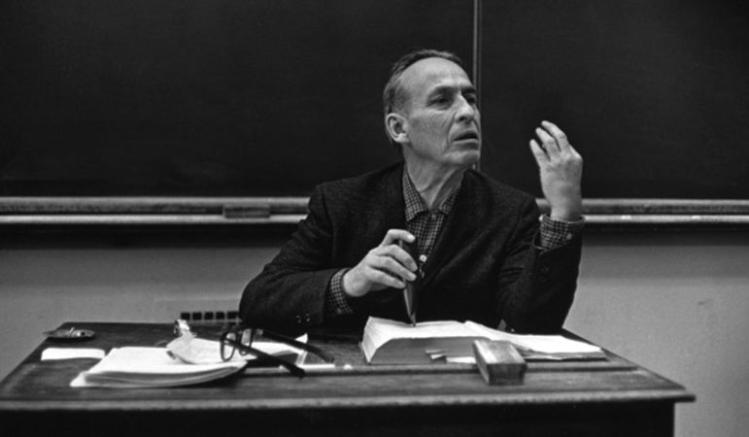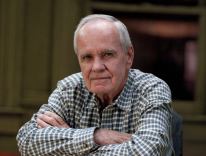
Late one May night in 1938, residents of a south-side Chicago neighborhood heard sounds of a struggle beyond their doors, and in the morning discovered a body lying in the alley outside. The victim, with a fractured skull and four dollars in his pocket, was a thirty-two-year-old newspaperman named Paul MacLean who worked in the University of Chicago’s press-relations bureau. A Dartmouth graduate, MacLean had worked on papers in Montana before coming to Chicago. He was known for his skill as a writer—and his hot temper. Though the investigating officer reported that MacLean “had battled fiercely with his assailants before being subdued,” the events leading to his death that night would remain unclear, and his killer was never caught.
Ordinarily, such a death would pass quietly into the forgetfulness of time. But MacLean had a brother, older by three years, who couldn’t let that happen. Like Paul, Norman Maclean (he kept the original spelling of their family name) was born in Iowa and grew up in Montana; like him, he learned to write under the tutelage of their father, studied at Dartmouth and went on to work in Chicago, teaching literature at the University of Chicago. Unlike Paul, however, Norman would live on. For more than half a century he would brood over his brother’s death; and in the last years of his own life this brooding would assist him in bringing forth two classics of American literature.
While Maclean, who died in 1990, first made a name for himself in 1976 with A River Runs Through It, my immersion in his writing would not begin until two years after his death with the posthumously published Young Men and Fire. The story traces back to 1949, when thirteen young men—skilled and daring, as Maclean’s brother had been—had died fighting a Montana forest fire known as the Mann Gulch Fire. Maclean, then in his late forties, had been home visiting from Chicago, and had gone out to inspect the still-burning site. Like his brother’s death, this “bitter turn of the universe” would haunt him, and over time became a story he had to tell.
My appreciation for Young Men and Fire, and subsequent delight in Robert Redford’s film version of A River Runs Through It, brought me belatedly to the book that had made Maclean famous. I was drawn to the sober mountainscape of its cover, and to its compelling opening lines with their combination of religion, sly humor, and the luminous Northwestern out-of-doors:
In our family, there was no clear line between religion and fly fishing. We lived at the junction of great trout rivers in western Montana, and our father was a Presbyterian minister and a fly fisherman who tied his own flies and taught others. He told us about Christ’s disciples being fishermen, and we were left to assume, as my brother and I did, that all first-class fishermen on the Sea of Galilee were fly fishermen and that John, the favorite, was a dry-fly fisherman.
As the superb Redford adaptation made clear, A River Runs Through It was not so much about fishing as about the pain of loving and losing. Also clear was that while Maclean understood this experience in the light of Christian faith, he couldn’t quite trust Christianity’s promise of redemption. Tragedy—and whether we have an answer for it—was his abiding theme. It preoccupied him not only in River and Fire, but also in an earlier, abandoned work on Custer’s defeat at Little Big Horn, and in his academic writing as well. To Maclean tragedy was the most moving of literary forms because it recognizes, as he noted in the Custer manuscript, that “much of...life is spent marching and counter-marching over the scenes of previous defeats and in fortifying ourselves against those to come.” He put his interest in tragedy succinctly in an essay on King Lear: “The question of whether the universe is something like what Lear hoped it was or very close to what he feared it was, is still, tragically, the current question.” In his pursuit of this matter, Maclean has much in common with Herman Melville and Graham Greene. All three query a God—whose presence they aren’t entirely convinced of—about His way of doing business.
In A River Runs Through It and Young Men and Fire Maclean takes the same problem and approaches it from different angles. While River concludes with Paul’s death, Fire takes the death of the firefighters as its point of departure. Maclean pursues three questions left open by A River Runs Through It: How exactly did the death(s) occur? What do we, the living, owe to the dead? And what conclusions for our own lives are we to draw from these tragic facts? It is as if he uses the second book to test and refine perspectives advanced in the first.
A RIVER RUNS THROUGH IT confronts Maclean’s own direct experience with tragedy. Its contents are easily summarized. Two boys, close but competitive, grow up under the warm guidance of their parents. In particular their father—a Presbyterian minister—exerts a strong influence, teaching them, via the Bible and the art of fishing, how to live “beautifully” at the juncture of discipline and grace. As the boys grow, Norman proves to be a straight arrow and levelheaded fisherman, while the younger Paul is a brilliant fisherman—inventor of the difficult art of “shadow casting”—and inveterate risk taker. The story turns on Norman’s growing sense that his brother is headed toward a bad end, and on his futile attempts to deter him. The tragic power of this roman à clef derives from its keen presentation of familial love and of youth and beauty undercut. It disturbs with its reminder that “it is those we live with and love and should know who elude us.”
For Maclean the content of A River Runs Through It was a given—he’d lived this story and told it to his children—and so was its primary interpretive frame: the Christian faith of the Reverend Maclean, overarching the events and providing the first means of making sense of them. That we, too, might understand this tragedy in biblical terms is signaled by the opening reference to John’s Gospel—a source called up again in the book’s penultimate scene, in which Reverend Maclean considers the role of God’s Word (the Logos of the Gospel of John’s first chapter) in creation. This is but one of the book’s many scriptural invocations, including echoes of two biblical tales of brotherhood: Cain and Abel and the Prodigal Son. In A River Runs Through It, Cain’s question—“Am I my brother’s keeper?”—belongs to Norman, who struggles not only to embrace the duty of brotherly love but to find the proper way to help his brother, a challenge complicated by sibling rivalry. Like biblical brothers, Norman and Paul strive for the approval of their father, and if Norman’s admiration for Paul is sincere, it is also inflected by envy at his brother’s prowess. As in the Prodigal Son story, when Paul, the less dutiful son, is home, there’s an air of celebration.
Less obvious but equally pertinent is Maclean’s reference to Psalm 23. He explored his admiration for this Psalm in a 1977 remembrance, “The Woods, Books, and Truant Officers,” [*] and in A River Runs Through It the Psalm, invoked on page one, provides a map to the book as a whole. Maclean summons it when he writes, “[the Reverend Maclean] was anxious to be on the hills where he could restore his soul and be filled again to overflowing” and again when he cites the Reverend’s insistence on the word “rod” over fishing pole (cf. “thy rod and thy staff they comfort me”). River as a whole reflects the trajectory and imagery of Psalm 23, moving from the green pastures and still waters of the boys’ youth through “the valley of the shadow of death” (Black Jack’s bar, the jailhouse, the canyons of the river) to a bountiful table prepared in the implicit presence of one’s enemies. And the confident assertion at the end of Psalm 23—“surely goodness and mercy shall follow me all the days of my life; and I will dwell in the house of the Lord forever”—is precisely the question the book leaves open. Do goodness and mercy follow us? Do we dwell eternally in the house of the Lord? Is it truly so?
Maclean’s re-invocation of John’s Gospel late in the book would seem to offer a reassuring answer. In this scene, just before Paul lands his last big fish, Norman comes upon his father reading his Greek New Testament on the riverbank. The Reverend Maclean observes: “In the part I was reading, it says the Word was in the beginning, and that’s right. I used to think water was first, but if you listen closely, you will hear that the words are underneath the water.” The observation, which compares the creation accounts of Genesis and John’s Gospel, affirms that divine love and reason underwrite the natural order. But what follows strikes a note of ambiguity. In quick succession we see Paul at the height of his artistry, reeling in the fish that marks his “limit”—a Wordsworthian “spot of time” suggesting God’s design in nature—followed by the family’s coming to terms with news of his death. The book then closes with a beautiful and subdued soliloquy:
Now nearly all those I loved and did not understand when I was young are dead, but I still reach out to them.
Of course, now I am too old to be much of a fisherman, and now of course I usually fish the big waters alone, although some friends think I shouldn’t. Like many fly fisherman in western Montana where the summer days are almost Arctic in length, I often do not start fishing until the cool of the evening. Then in the Arctic half-light of the canyon, all existence fades to a being with my soul and memories of the Big Blackfoot River and a four-count rhythm and the hope that a fish will rise.
Eventually, all things merge into one, and a river runs through it. The river was cut by the world’s great flood and runs over rocks from the basement of time. On some of the rocks are timeless raindrops. Under the rocks are the words, and some of the words are theirs.
I am haunted by waters.
The light here is significantly not the dawn of resurrection, but an “Arctic half-light” within which the living reach out to the dead. Rather than serene assuredness, we find an intuition of ultimate oneness and “the hope that a fish will rise.”
ASKED ABOUT HIS own faith in 1986, ten years after the completion of River, Maclean called himself a “religious agnostic.”
There are things that make me feel a lot better. I don’t particularly find them in a church. I find them in the woods, and in wonderful people.... I feel I have company about me when I’m alone in the woods. They’re a kind of religion to me.... I certainly feel that there are men and women whom I’ve known and still know who are really above what one could think was humanly possible. They and the mountains are for me “what passeth human understanding.”
At the time, however, the writer was deeply immersed in a project that would show just how strong a hold the Christian tradition still had on his imagination. Maclean had started work on Young Men and Fire shortly after the publication of A River Runs Through It. In a 1980 letter he jokingly suggested a connection between the two, calling the working title for the new book A Wildfire Runs Through It. In the same letter he said he was only three or four months away from completing it. Yet at his death a decade later, in 1990, it still wasn’t done. Why?
The delay partly reflected the waning energies of old age. In the latter stages of writing Young Men and Fire, Maclean was well into his eighties and suffering from heart disease. But there was more to it than that. When editors of the University of Chicago Press, in the aftermath of his death, set about putting Fire into publishable form, they found a story essentially complete. Maclean had conducted interviews, revisited the fire site with survivors, delved into the archives of the U.S. Forest Service, applied mathematical models of fire, and written it all up. All that remained was a proper tying-together. To its credit, the press did so beautifully. Yet I think the “Publisher’s Note” fails to account fully for why Maclean couldn’t get the job done. “Young Men and Fire had become a story in search of itself as a story, following where Maclean’s compassion led it,” the editors write. “As long as the manuscript sustained itself and its author in this process of discovery, it had to remain in some sense unfinished.” I would go a step further: Maclean had set out to tell “the truth” of the tragedy, but couldn’t settle finally on what the truth was.
Maclean had already expressed his preoccupation with telling the truth on the last page of A River Runs Through It. There, Reverend Maclean asks, “You like to tell true stories, don’t you?”—to which Norman replies, “Yes, I like to tell stories that are true.” And in Young Men and Fire he writes that “the only poem I had a chance of writing about the Mann Gulch fire was the truth of it.” But how best to get at the truth? Maclean knew there can be more than one approach; indeed, in Fire he struggles to reconcile three: science, poetry, and faith. The first order of business is to get the facts straight—“to find out exactly what happened,” he writes. To this end he knew that methods of scientific and historical research were well suited. He himself had already applied them in his work on the Custer project and in his co-authorship of a 1943 manual on military maps. Training, equipment, fire and weather conditions, tactics on the ground: to comprehend the “Smokejumpers” who parachuted in to fight the Mann Gulch forest fire, Maclean gathers as much information as he can and then maps, literally and figuratively, the race between men and fire. “This is a story,” he writes, “in which cartography and plot are much the same thing.”
But he also knew that facts and maps take us only so far, and that humans recognize themselves not in data but in stories. So instead of giving us a research report, he takes us inside the Smokejumper’s mind as the plane circles the fire. “Each of the crew is sitting between the other’s legs, and all this is leading to a single act performed between heaven and earth by you alone.” We join the Smokejumper as he falls “like a seed in the wind.” We feel his boldness give way as the fire encroaches and his world contracts, salvation narrowing at last to a crevice in a reef of rock.
Maclean tells us that most of the Smokejumpers believe in God. “You wouldn’t dare jump,” they say, “if it was empty out there.” But of the sixteen who descended to fight the fire, only three survived. What then—for them, for us—is the last word in this story? Does the Mann Gulch fire reveal the ultimate tragedy of all human experience? Or does it enjoin us to embrace the world’s faith traditions in looking for a life and a truth beyond death? As in A River Runs Through It, Maclean counters fatalism with Christian symbols and biblical allusions, including references to the Stations of the Cross, the Mass, Calvary, and the Book of Job. He also calls again on Psalm 23. But perhaps the most telling biblical reference in Young Men and Fire is the scorched deer included in the “Black Ghost” section. This image, reinforced in a photograph, calls to mind Psalm 42: “As a deer longs for running streams, so longs my soul for You, O God.” Here, as in Maclean’s earlier book, the river is a potential source of relief and rescue—not the Big Blackfoot this time, but the Missouri, sporadically “glaring” through the smoke and trees. The ambivalence is typical of both of his books and very much to Maclean’s point; it sharpens our sense of the tragedy without “answering” it in any definitive way.
Given Maclean’s Christian framing, might we call A River Runs Through It and Young Men and Fire examples of “Christian tragedy”? As the critic Michael Edwards has pointed out, we may call a tragedy a Christian one when it offsets pain and loss with evidence of “a victory of a different order.” I expect Maclean himself would have balked at the Christian tag; yet I find such evidence in both of his books. His determination to honor his subjects and join them in their defeat is a commendable and transcendent work of mercy. And in his writing I hear more than he himself says outright. A river is of course a symbol of the Holy Spirit—recall the river of Eden and the River Jordan—and St. Paul reminds us that the Spirit speaks up for us when we are unable. In Maclean’s work I hear this Spirit speaking reassuringly where the man himself is reticent.
[*] An earlier version of this piece incorrectly identified “The Woods, Books, and Truant Officers” as a short story.
Please email comments to [email protected] and join the conversation on our Facebook page.
Share
Previous Story
Last Word: St. Gregory in the Congo
Next Story
Sean Penn's Mexican Adventure


